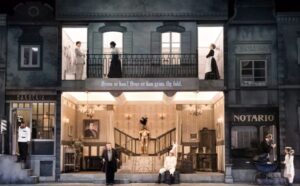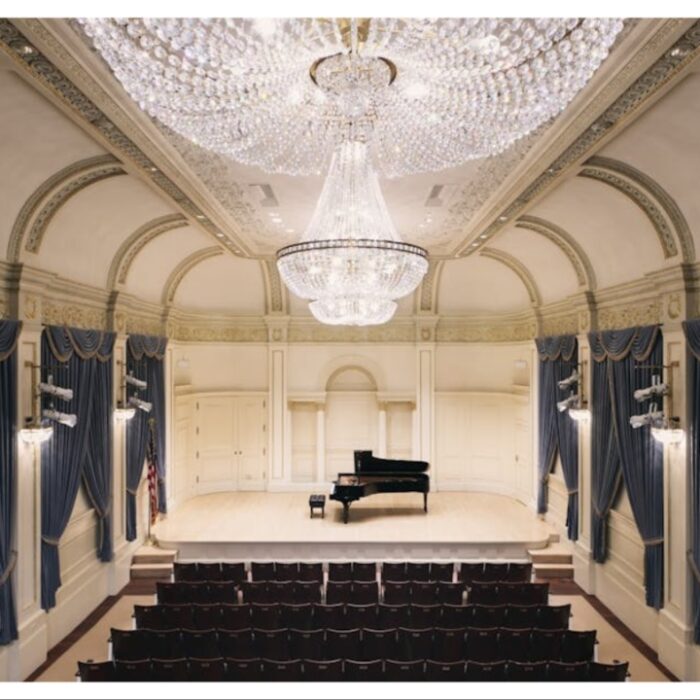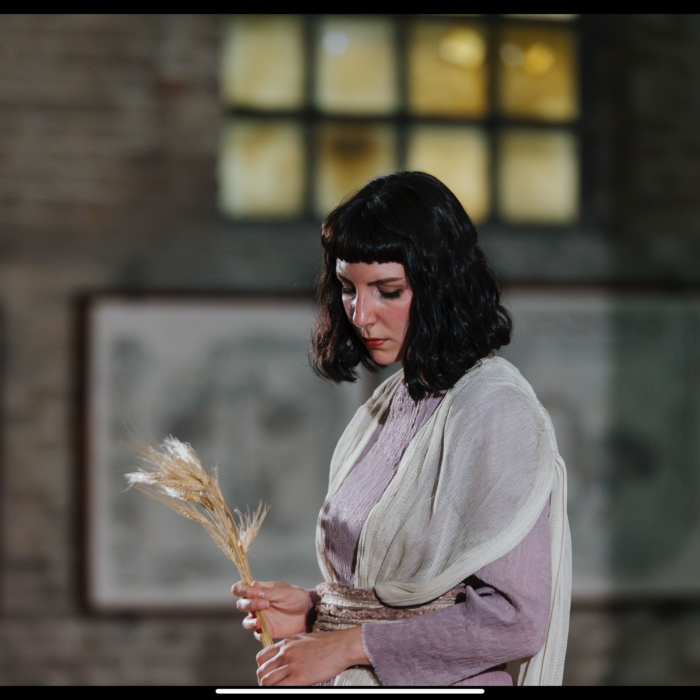
Royal Danish Opera 2025 Review: The Barber of Seville
By Bernardo Gaitan(Photo: Miklos Szabo)
It is well known that the premiere night of “The Barber of Seville” was a resounding failure. A series of onstage mishaps, boos from the audience, and even a black cat crossing the stage forced Gioachino Rossini to flee the theater to avoid, in his own words, “being killed by the audience for their unbridled passion.” Yet today, there is no theater in the world —no matter how small— that hasn’t staged the “Barbiere,” nor a singer in training who hasn’t performed one of its arias or ensemble pieces.
How many productions of “The Barber of Seville” are staged globally each year? It’s impossible to say, but surely several hundred. One more performance of Figaro’s adventures might seem unremarkable, but to stand out in this saturated Barberian landscape, the Royal Danish Opera offered a bold, innovative, and highly functional production at its main venue, the Kongelige Teater in Copenhagen.
If Danes are known for anything, it’s for their practicality and innovation, and this production deserves a place in history for exemplifying both. It was a shortened version, with numerous cuts reducing the performance by nearly 40 minutes! The character of Fiorello was entirely removed; the tenor’s two arias (“Ecco ridente in cielo” and “Cessa di più resistere”) were cut, along with Berta’s “Il marito cerca moglie” and all choral parts, as there was no chorus at all. Despite these drastic omissions, the plot remained intact, and the concise format helped keep the audience’s attention throughout.
Martin Lyngbo’s stage direction was another highlight. Meticulously detailed, filled with physical gags and impeccable timing, his work earned a standing ovation at the end of the performance. Inspired by silent film, the Danish regista made full use of the cutting-edge stage technology of the modern Scandinavian theater, inaugurated in 2005.
Rikke Juellund’s black-and-white set design evoked the silent film era and provided a perfect backdrop for genuine laughter from the Baltic audience. Every corner of Don Bartolo’s house was visible onstage: his study, a hallway, even a bathroom, cleverly used for physical comedy as characters were shown using it. To the right was the notary’s office, and to the left —as the libretto specifies— stood Figaro’s barbershop, complete with four steps, five wigs, and the number 15 on its façade. Danish surtitles were projected in different parts of the set depending on where the action occurred: on the lower wall for scenes in the street and above the façade when Rosina sang from the balcony, making the translation particularly dynamic to follow.
Kristján Ingimarsson’s choreography was essential due to the high number of physical gags. Precise synchronization was key to the production’s success: falls, bumps, and ensemble actions that, if not thoroughly rehearsed, could have felt clumsy or forced.
Vocally, the cast was solid. Liam Bonthrone portrayed a charming and effective Count of Almaviva. The Scottish tenor delivered light but beautiful high notes, displayed agile coloratura and a strong middle register. His clear Italian diction and confident stage presence confirmed him as an ideal fit for the role. Unfortunately, the absence of his arias deprived the audience of key moments that would have further showcased his talent. Valerie Eickhoff, on the other hand, gave a fantastic performance as Rosina. The mezzo-soprano offered clean, resonant coloratura, a velvety yet powerful voice, and a convincing portrayal of a seductive and cunning Rosina.
It was not the best night for Theodore Platt, who sang Figaro with notable vocal issues. During the iconic “Largo al factotum,” he forgot part of the text and replaced a stanza with improvised words that resembled Italian. The Danish audience likely didn’t notice, but given the prominence of the aria, the lapse stood out. He may have been unwell, as despite a sonorous upper register, he struggled to sing beyond a C6 without vocal strain. Nonetheless, his vis comica carried him through: his Figaro was funny and handled the many physical gags with ease.
The lower voices were equally strong. Tiziano Bracci as Bartolo was entertaining, his Italian naturalness bringing out sparkling details that delighted the audience. Sadly, many of his parts were cut, it would have been interesting to hear the Milanese singer in a full version of the role. Henning von Schulman as Basilio was equally consistent both in stage presence and vocal delivery. His deep, resonant bass was particularly well-phrased and beautiful. It was also unfortunate that Berta’s aria was omitted, as Taya Lukashova offered a theatrically complete character. Her few ensemble appearances revealed a powerful soprano voice with expressive potential.
The musical direction was masterfully handled by Matteo Beltrami, who led the historic Royal Danish Orchestra —active since 1448— with brilliance. The Italian conductor brought dynamics in perfect Rossinian style, with lively, energetic tempi. His stylistic command and conducting experience were evident from the iconic overture through the final ensemble numbers and the arias’ cabalettas.
This production triumphed thanks to its geographical context, undoubtedly, if it had been presented in Central Europe, -particularly in Italy-, it would not have received the warm reception it enjoyed from the Copenhagen audience.



